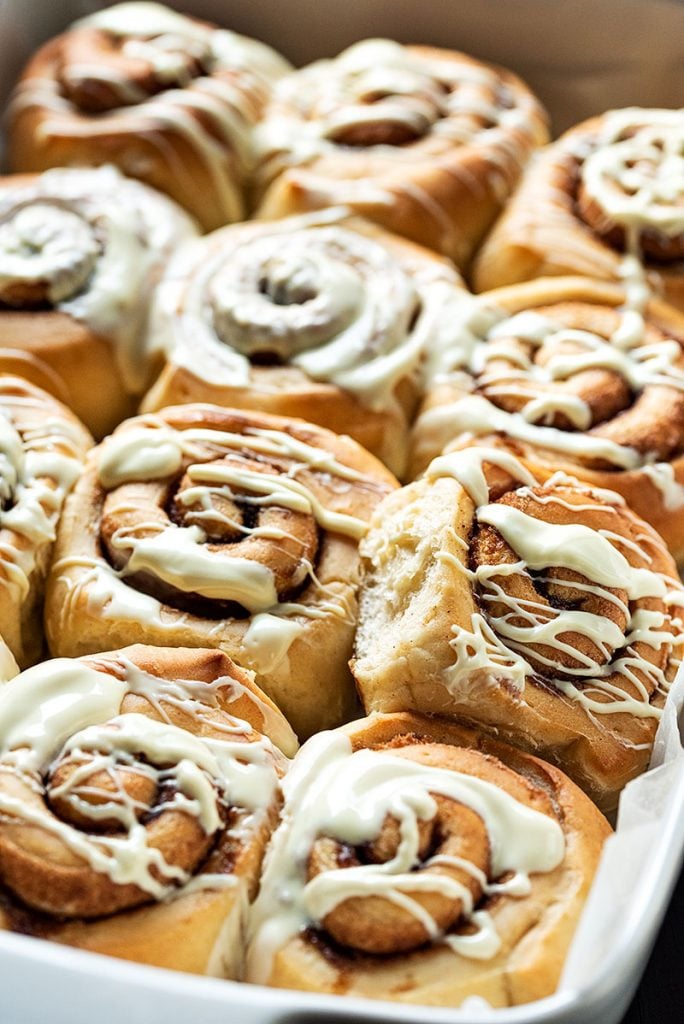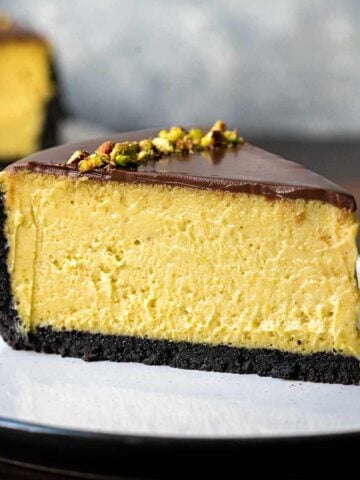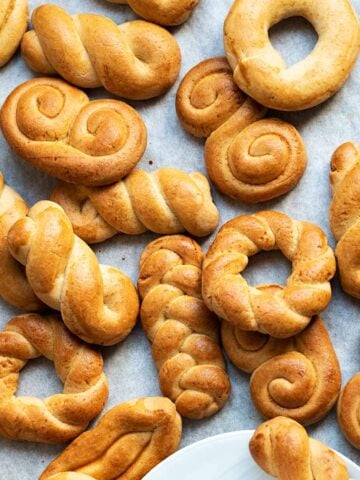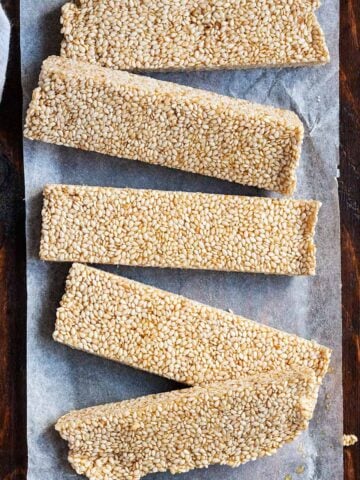Tsoureki is a Greek Easter bread similar to Brioche or Challah with a soft, stringy texture and amazing taste! This is an easy recipe with sweetened condensed milk for a perfect, moist and fluffy result.

Tsoureki is one of the most popular Greek desserts. On Holy Thursday, everyone in Greece bakes Tsoureki and Koulourakia (Greek Easter cookies). This sweet bread is sometimes adorned with one or more Easter eggs. The dough is very rich and flavorful because it contains milk, sugar, eggs and butter.
In that sense, Tsoureki is similar to a brioche or Challah but has a fabulous stringy texture and a characteristic aroma from a spice called mahlab.
Mahlab is the pit from a certain sour cherry variety and it's actually one of my favorite spices! Many times mastic is also used to compliment the flavor of this Greek Easter bread, but I personally don't find it obligatory.
If you add the mahlab, some cinnamon and the zest of an orange, the smell is intoxicating enough to make you dream of it for many days and nights!
If you love Greek bread recipes make sure to check this Greek village bread (horiatiko psomi)!

Baking a sweet bread for Easter is a tradition in many countries and Greece is not an exception. Every Greek, after having a roasted leg of goat (or lamb) expects (or even demands) a thick slice of tsoureki for dessert.
There are a lot of Greek recipes for Tsoureki, all of them extremely delicious, but some are more difficult than others.
This is an easy recipe which will give you a delicious, aromatic and stringy Tsoureki with minimum effort. I believe that the sweetened condensed milk helps to keep it soft and fluffy for longer time.
Other Tsoureki recipes you can find in this blog is this chocolate stuffed Greek Easter bread and this Tsoureki wreath made with olive oil.

Ingredients
Flour:
It's very important to use bread flour and not all purpose flour or cake flour. Bread flour is a type of white flour with a high protein content (about 13% - 16% by weight).
Protein content is important because more protein equals more gluten which makes the dough more elastic and results in higher-rising loaves. It is also very important for the right stringy texture.
Yeast:
Yeast is a raising agent which helps the dough to rise and become fluffy and soft. For this recipe fresh yeast is used but you can also use active dry yeast without any problems.
Also, a small amount of baking powder is mixed in the flour to make the bread even fluffier.
Eggs:
Eggs make the tsoureki richer in taste so try to use fresh, free range eggs. This recipe asks for large eggs. Weighed without the shell, 1 large egg is about 1.8 oz or 50-55 grams
Sweetened condensed milk:
Instead of regular milk and sugar this recipe uses sweetened condensed milk which helps to keep the tsoureki soft and fluffy for many days.
Aromatics:
Mahlab (or Mahlepi) is the main spice that gives the Tsoureki its characteristic aroma. Mahlab is a small, wild cherry pit from the St. Lucy cherry. It has cherry, rose and bitter almond notes.
Other complimentary spices you can add are cinnamon, a pinch of cloves, orange (or lemon) zest, cardamom, mastic, vanilla.
Fat:
The traditional tsoureki is made with butter. However, there have been times when I replaced the butter with olive oil and the result was equally delicious!
Tips for the best texture
For every bread (sweet or savory) to have a stringy texture the development of gluten is very important.
So, the question is: How do you develop gluten?
1. First, you have to use a wheat flour high in gluten (the ingredient list should say that the protein content is more than 12% and ideally at around 15%).
This flour is often called bread flour and will give you the right base to work with. Don't use a yellow bread flour or a whole wheat flour.
2. Adding about 1 tablespooon of vital wheat gluten (large flour companies sell it online) per pound of flour will make the dough extremely stretchy and elastic!
I still hadn't the chance to experiment with wheat gluten, but as soon as I use it I will show you the results on my Instagram.
Update: I tried it and it makes a huge difference!
3. Sugar and butter inhibit gluten formation. If you want to prevent this, you can set aside the butter and the sugar, make the dough and knead it for some time to start the gluten development.
Then add the sugar and the butter gradually, while kneading. Sugar is harder to incorporate to the dough once it's mixed and that's why I prefer to add it from the start.
I keep the butter for the end of kneading (sometimes I even add it after the first rise).
4. Knead the dough for a long time. When you're making tsoureki, you can never knead enough, there's always room for more!
If you have a stand mixer, your life is easy. Just let it work for 20-30 minutes until the dough is soft and very elastic. If you want to knead by hand, take your time and enjoy the process. Kneading is a peaceful and calming process and I guarantee you'll enjoy it.
Note that if you knead by hand, it can be useful to keep some butter aside for your hands, for when the dough gets very sticky.
5. If you have the time you can let the dough rest in the fridge overnight (after the first rise). Yes, you guessed it right! Resting the dough promotes gluten development but also helps the flavors mature and blend together.
Shape the tsoureki the next day and continue according to the recipe. Keep in mind that because the dough will be cold, the second rise will take longer.
6. Finally, there's also a certain technique used in Hokkaido bread, which I have also seen used in tsoureki recipes, that makes it extra stringy.
I don't use it here because I wanted to keep the recipe easy. You will probably see me using it in another recipe in the future!

What yeast to use?
I have noticed that fresh yeast usually makes the bread dough rise faster and has a slightly more pleasant smell.
However, dry yeast is also fine. In plain bread recipes, usually 25 grams of fresh yeast or 1 tablespoon of dry yeast is enough to make the dough rise. In a richer dough like this Tsoureki a higher amount of yeast is needed to make it rise more efficiently.
How to know when it's ready for baking:
The easiest way is the poking test as Natasa from my daily sourdough bread describes:
In the poking test, we test the dough resistance and elasticity by pressing into the dough and observing its reaction. The test does not work immediately after you knead the dough, you should first let it rest and rise and then poke it with your finger, about half an inch deep.
- underfermented bread: the indent fills up quickly (the gluten strands are strong, but somehow not elastic enough to allow the expansion of the dough)
- overfermented bread: the indent stays as it is (gluten strands have weakened)
- perfectly fermented: the indent comes back half way through (gluten strands are strong and elastic, meaning the expansion of the dough can be expected)
Many people also estimate when the loaf has almost doubled in volume and then put it in the oven, but because this is a 3D object it's not always easy to do a correct estimation, especially if someone is not an experienced baker.
🎥Recipe Video
📖 Recipe

Tsoureki – Greek Easter Bread
Ingredients
For the yeast mixture:
- ½ cup (120 grams) warm water
- a pinch of sugar
- 1.76 oz (50 grams) fresh yeast (or 2 tablespoons/18 grams instant dry yeast)
For the Tsoureki:
- 6 cups (780 grams) bread flour
- 2 teaspoons baking powder
- ½ teaspoon salt
- 4 teaspoons ground mahlab
- 1 teaspoon cinnamon
- 1 tablespoon orange zest ((or 1 teaspoon ground cardamom))
- 2 teaspoons vanilla extract ((or ¼ teaspoon ground mastic))
- 4 large eggs ((230 grams))
- ¼ cup (50 grams) white sugar (optional)
- 1 can sweetened condensed milk ((14 oz/400 grams))
- ⅔ cups (160 grams) butter in cubes - at room temperature
For the eggwash:
- 1 egg
- 2 tablespoons milk
- a pinch of sugar
Instructions
- Proof the yeast: Transfer the water, the pinch of sugar and the yeast to a small bowl and mix well until the yeast is dissolved. Let it aside for 5-10 minutes until you can see some foam on the surface.
- Make the dough: Transfer most of the flour (keep ¼ of a cup aside), the baking powder, the salt, the mahlab, the cinnamon, the orange zest, the vanilla, the eggs, the sugar, the sweetened condensed milk and the yeast mixture to the bowl of your electric mixer. Mix with the dough attachment for 5 minutes.
- Start adding the butter gradually, while the mixer is working. If the dough is very soft and sticky add the rest of the flour you've kept aside. Kned the dough for 20-30 minutes until it is smooth and elastic.
- First rise: Cover the bowl with a piece of plastic wrap or a clean towel and let it rest in a warm place until tripled in volume (usually it takes 3-4 hours). A warmed and turned-off oven with only the oven light on is the perfect place to rest the dough.
- Shape the Tsoureki: Once the dough has tripled in volume take it out of the bowl, knead it for a few seconds to deflate it, then cut it in half. Cut each half into 3 equal pieces and roll them into 17.7 inches (45 cm) long strings. Form the strings into a braid and transfer it on a baking pan lined with parchment paper (do the same with the second half of the dough).
- Second rise: Transfer the pans to a warm place and let the bread rest until almost doubled in volume.
- Preheat your oven at 330°F (165°C)
- Egg wash and Bake: Transfer the egg, the milk and the sugar to a small bowl and beat with a fork. Brush each bread with the egg wash and bake for about 35-40 minutes or until a toothpick inserted in the thickest part of the bread comes out clean. If the bread starts to brown quickly, cover with foil after the first 20 minutes. Take the tsoureki out of the oven and transfer on a cooling rack to cool completely.
Notes
- Portions: This recipe makes 2 large loaves 2 pounds (900 grams) each or 3 medium ones 1.3 pounds (600 grams) each.
- If the two tsourekia fit on the same pan, you can bake them together but they might need a bit more baking time.
- If you want to halve the recipe, then half a can of sweetened condensed milk is almost ⅔ of a cup (160 ml/200grams). Transfer the remaining milk to a ziploc bag and store it in the freezer for later use.
- You may need some extra flour. Have half a cup of flour aside and gradually add it to the dough after the first rise, only if it's very sticky.
- You can omit the sugar if you like the tsoureki less sweet, but I prefer using it.
- Spices: If you only have whole mahlab seeds, you can ground them in a mortar and then pass them through a fine sieve. If you like mastic keep in mind that too much can be bitter. Use 1-2 tears of mastic and ground them in a mortar with a tablespoon of sugar.
Nutrition



If you like this recipe, Pin it!






George says
One of the easiest tsoureki recipes and so delicious
Makos says
Very happy you liked it!
Denis says
Some great tips for tsoureki making. I’ve started learning so reading many sites to get a wholistic view. This one in particular was great thank you.
Makos says
Thank you Denis, it means a lot 🙂
Sylvie says
It’s my favourite time of year — tsoureki-making time!
I wondered if you could taste the difference between the sweetened condensed vs. milk and sugar version?
Lots of great tips here, like the Japanese roux. And I never thought of checking to see how much protein my flour has. I can never seem to find “bread flour” in the markets here.
Always a pleasure visiting your blog Makos. Wonderful recipes and images!
Kalo Pasha!
Makos says
Hi Sylvie, thank you for your kind words!
Flavor-wise you can't taste the difference, for me all tsoureki recipes are delicious when done right 🙂 It just has to do with easiness.
Kalo Pasha to you and your loved ones!